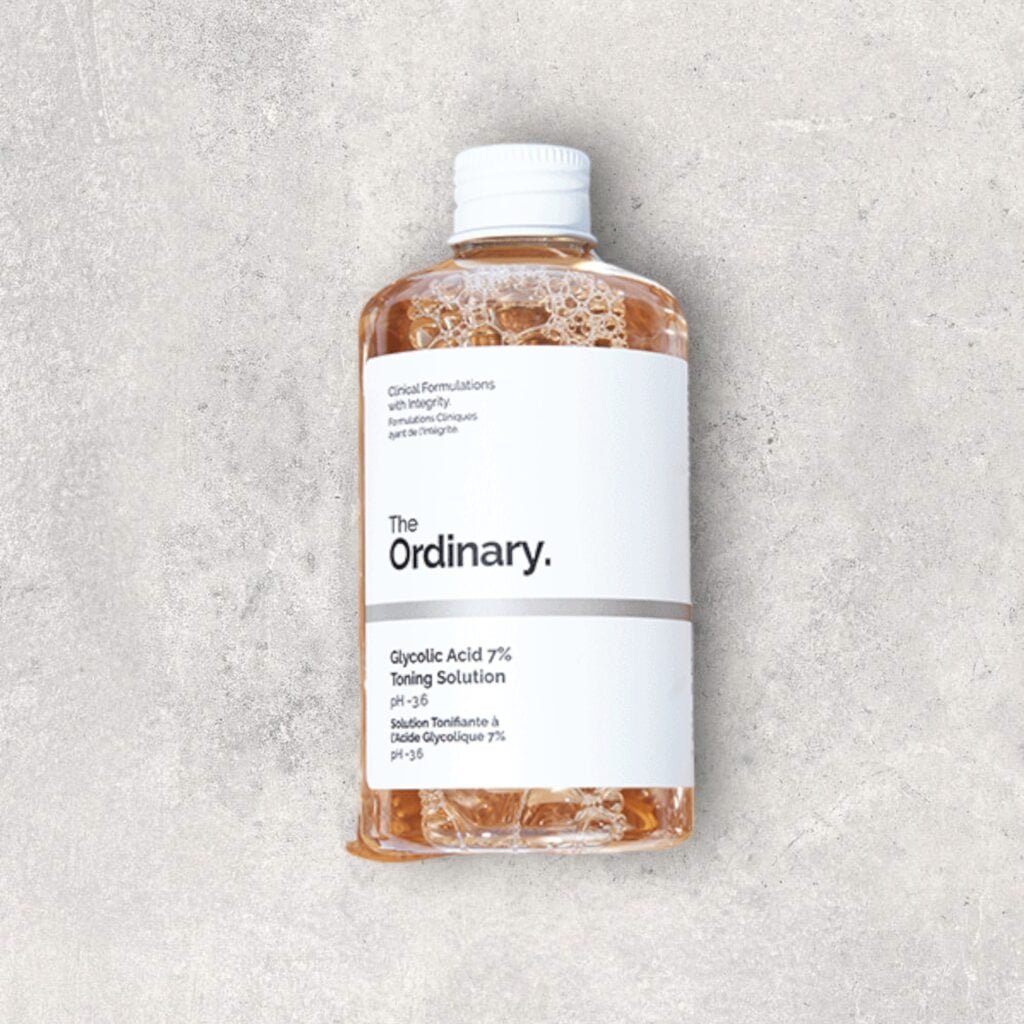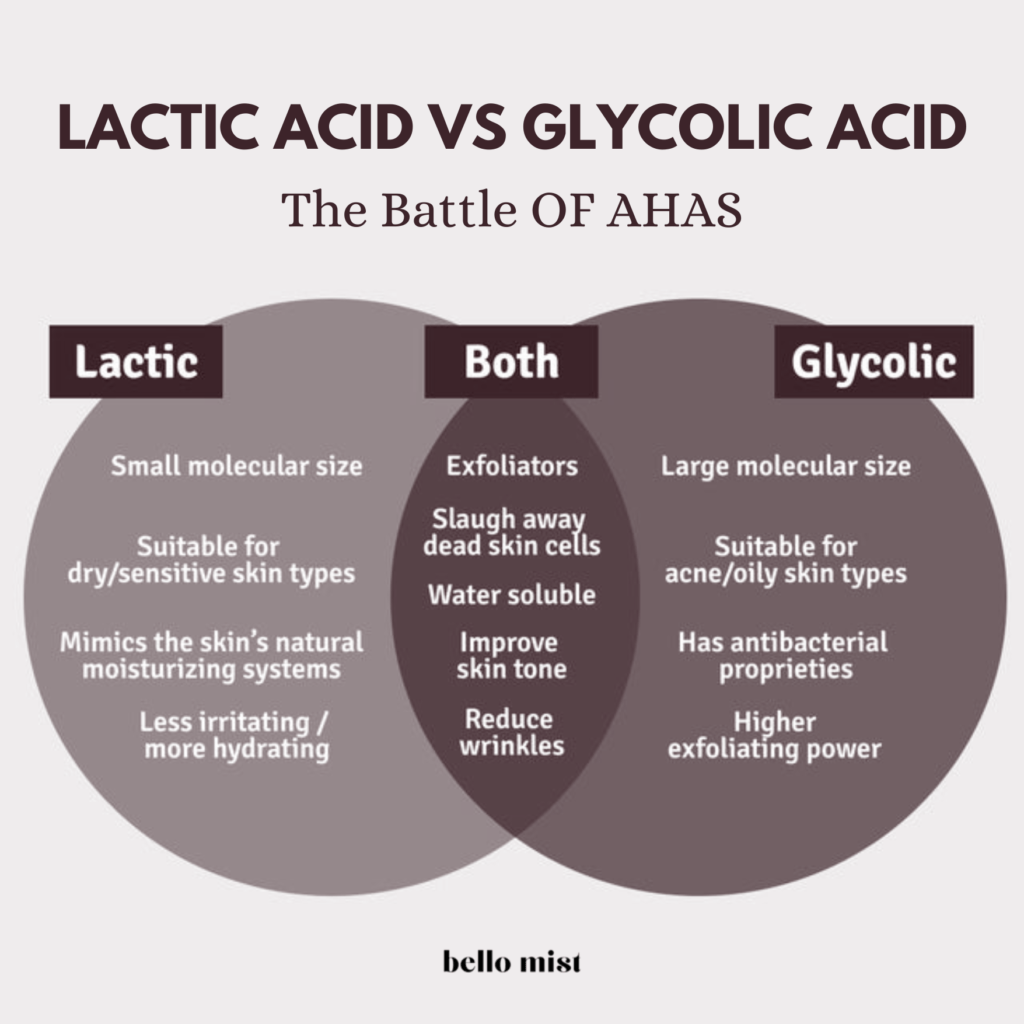Can you combine glycolic acid and vitamin C for radiant skin? Here’s everything you must know about this skincare power duo.
Experimenting with different skin care components can be overwhelming, and missteps can cause skin reactions that are anything but pleasant. To save yourself from the hassle of trial and error, it helps to learn which ingredients work well together and which don’t.
Vitamin C and glycolic acid both have antioxidant properties, which can help protect your skin from environmental damage and slow down the signs of aging.
Glycolic acid and vitamin C can also help to decrease the appearance of dark spots and discoloration and improve overall skin tone and texture.
So if you’re wondering whether or not you can combine glycolic acid and vitamin C, Bello Mist is here to give you all the necessary information.
What is glycolic acid and how does it work?

Alpha-hydroxy acids (AHAs) are popular among skincare providers, and glycolic acid is a significant part of this group. AHAs are found organically in various sources, such as sugar cane, dairy, and fruits like pineapple, grapes, and beets.
Glycolic acid is potent for its exfoliation abilities. It breaks down the bonds between dead skin cells, making it easier for them to be removed and leaving behind brighter, smoother skin with a natural glow.
Glycolic acid is incredibly successful due to its small molecular size, allowing it to penetrate easily through the layer of dead skin cells. This diminutive size also makes it gentler than other skincare ingredients. And, since glycolic acid and other AHAs are soluble in water, they are primarily used for treating the upper layer of the skin.
On the other hand, if you would like something that works further into the skin, a Beta-hydroxy acid (BHA) would be a better choice as it is oil-soluble and can penetrate pores.

Glycolic acid benefits
As we told earlier, glycolic acid is the smallest of the AHAs, so it’s able to penetrate the deepest, providing several advantages:
- Exfoliating dead cells from the skin’s surface
- Unclogging pores
- Evening skin tone
- Stimulating the production of hyaluronic acid
- Boosting skin’s collagen production
Because it’s expert at exfoliating and hydrating, glycolic acid is perfect for dry, dehydrated, and combination skin.

What is vitamin C and how does it work?
When it comes to robust skincare solutions, vitamin C is undoubtedly one of the top contenders. It is known to have antioxidant properties that can save the skin from damage caused by free radicals. These molecules lack an electron and can cause havoc when not neutralized.
Vitamin C can provide its electrons to these free radicals, thus preventing them from damaging the body. This nutrient is naturally present in the dermis and epidermis layers of the skin.
Its high concentration in the epidermis makes it essential in protecting and strengthening the skin. However, with age and prolonged sun exposure, vitamin C levels in the skin can start to decrease.
Vitamin C is essential for collagen production, acting as a regulator in the process. Additionally, it helps keep the collagen together after it is produced.
Collagen, the most abundant protein in the body, helps give skin vitality, firmness, and volume – all of which assist in making skin appear younger. Unfortunately, collagen diminishes with age, making it crucial to maintain it through a skincare routine.

Vitamin C benefits
Vitamin C has a powerful antioxidative effect and is available in various shapes and forms. L-ascorbic acid is the most well-researched and powerful option, while something like sodium ascorbyl phosphate is a bit more sturdy and gentle on the skin, although not as potent.
Vitamin C has many advantages for the skin, including:
- Neutralizing free radicals that cause skin damage
- Stimulating collagen production
- Inhibiting melanin production
- Smoothing fine lines and wrinkles
- Protection against sun damage
The soundest way to introduce vitamin C into your skincare routine is to find an effective yet gentle formula. We highly recommend utilizing a stabilized ascorbic acid serum suitable for all skin types.
It includes the nourishing benefits of niacinamide, ferulic acid, and hyaluronic acid — all of which can help improve the formation of fine lines and dark spots and even promote a brighter-looking complexion over time.
Can you combine glycolic acid and vitamin C?
It is possible to incorporate vitamin C and glycolic acid into one skincare regimen. However, the type of Vitamin C you select will determine the timing of their use. In particular, vitamin C must be formulated at the correct pH to penetrate the skin – the same goes for glycolic acid.
Vitamin C, for instance, is known to be temperamental when not incorporated into specially-created skin products, like serums. These mixes usually have a pH balance of around 3, which is on the more acidic side, but still works. When putting it on your skin, you should keep it at this acidic level.
Glycolic acid and other chemical exfoliants have an even lower pH level, which is very acidic. If glycolic acid and vitamin C are applied together in the same product or consecutively, it can cause skin irritation, redness, and rashes.
We suggest applying one in the morning, and the other in the evening and highly endorse ascorbic acid under sunscreen due to its powerful antioxidant properties.
In contrast, glycolic acid can be used at night to brighten your skin tone, diminish dark spots, and reduce the appearance of wrinkles.

How to add glycolic acid and vitamin c to your skincare routine?
We advise you to use glycolic acid and vitamin C on your bare skin for an optimal experience.
After cleansing, start by applying Vitamin C in the morning. Afterward, you may use other skincare products like moisturizers or additional antioxidants before sunscreen.
Utilizing Vitamin C in the morning helps to activate its antioxidant capabilities. Look for a product that contains 10% L-ascorbic Acid, which is more biologically active, so your skin can benefit as soon as possible.
Glycolic Acid should be used at night and followed by a moisturizer. This will help eliminate any dirt or buildup throughout the day while keeping your skin balanced.
If you have sensitive skin, avoid using Glycolic Acid every night. You can use lactic Acid, a more gentle Acid than glycolic.

Can you use vitamin C and AHA together?
Maintaining a balanced pH level for your skincare routine to be effective is essential. Alpha Hydroxy Acids will have the same effect as glycolic acid, so you should use them in the same way as glycolic acid and vitamin C.
It’s essential to consider your skin type as it will decide which AHA you can use and how often you should use them. If you have oily skin, glycolic acid and salicylic acid are beneficial, while those with dry skin will benefit from lactic acid or mild PHAs.
If you are new to any of these ingredients, like glycolic acid and vitamin C, you should do a patch test before using the product on your skin.

Which goes first: glycolic acid or vitamin C?
If you’re looking to add AHAs such as glycolic acid to your skincare routine, it’s important to note that the pH level of these ingredients is between 3 and 4.
Applying these acids to your skin will cause its pH to change, potentially resulting in adverse effects and hindering other components from working.
The experts advise applying vitamin C first, as this will provide the best environment for glycolic acid to rid the skin of any build-up of dirt and debris and improve your complexion.
Remember to leave a 15-minute gap between glycolic acid and vitamin C applications so your skin has time to reset, and the pH should balance out again before you add more ingredients.

Wrapping Up
Glycolic acid and vitamin C exist among the famous skincare ingredients today. It has been found through research that these two can brighten the skin and help to maintain an even skin tone while working to increase collagen production.
This is especially beneficial for those who are looking to reduce the appearance of aging, such as dullness, wrinkles, and discoloration.
To maximize the effectiveness of glycolic acid and vitamin C products, we recommend applying your vitamin C item first and following it up with glycolic acid.
It’s best for people with delicate skin not to use glycolic acid and vitamin C simultaneously and instead alternate the application of each one during the day.
Read More
CeraVe vitamin C serum review: Is it worth your money?
How to use CeraVe skincare products for maximum benefits.
Is CeraVe good for oily skin? An in-depth review.
